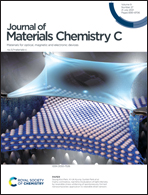Heterostructures of titanium-based MXenes in energy conversion and storage devices
Abstract
Due to the increasing market demand for graphene-based devices, van der Waals heterostructures based on 2D materials have increased rapidly worldwide during the last decade. Graphene-based applications are inadequate in some electronic devices such as field-effect transistors (FETs) and solar cells devices due to its intrinsic zero bandgap and complex mechanistic approach in related chemistry. Thus, it is highly desired to fill the gap and devote efforts to explore other 2D materials further, especially bi- and tri-elemental 2D materials, such as layered metal chalcogenides (LMDCs), metal oxides, and hexagonal boron nitride (hBN). During the past few years, a different research group contributed to improving the quality and performance of the mentioned 2D materials. Still, due to some deficiencies such as low conductivity and poor bandgap, there is a need to develop and investigate alternative materials. Recently, MXenes, which are compounds obtained due to the chemical delamination of quaternary or (ternary) layered nitrides or carbides, have been found as a great class of 2D elemental materials. The complex bonding in the MXene family (a mixture of metallic and covalent bonds) and other characteristics such as atomic stacking, electronic structures, surface terminal groups, and different synthetic routes are responsible for their unique properties such as hydrophilicity and metallicity, and they are predicted to have high elastic moduli in a single compound. On behalf of the rich chemistry and unique morphologies, MXene derivatives have delivered efficient sensors, energy storage materials, catalysts, and water purification materials. Although there is a great demand for MXene-based derivatives, there is further demand for their improvement such as the long-term stability, large scale production, as well as deposition and surface roughness, which create hurdles in their commercialization. Titanium-based MXene (Ti3C2Tx and Ti2CTx) heterostructures with other 2D nanomaterials are highly desired to solve the surface roughness problems and long-term stability as well as an alternative to overcome the deficiency of the scalable production of MXenes. The existence of different active functionalities (–O, –OH, –F, etc.) on the surface of Ti3C2Tx and Ti2CTx can be helpful for interacting with other 2D layered materials in the presence of solvents to fabricate heterostructures after using various deposition techniques such as spin coating, dip coating, and drop-casting for practical device fabrication processes. In the presence of weak interaction between the host (MXene derivatives) and guest (other nanostructures 2D materials), the intrinsic characteristics of both can be largely preserved for efficient energy storage applications. In this paper, we present a comprehensive literature library of the various strategies of 2D titanium-based MXenes such as Ti3C2Tx and Ti2CTx for the fabrication of their heterostructures with 2D materials using various deposition techniques and the application of the resultant structures in the fields of optoelectronics, catalysis, and energy storage devices.

- This article is part of the themed collection: Journal of Materials Chemistry C Lunar New Year collection 2022


 Please wait while we load your content...
Please wait while we load your content...